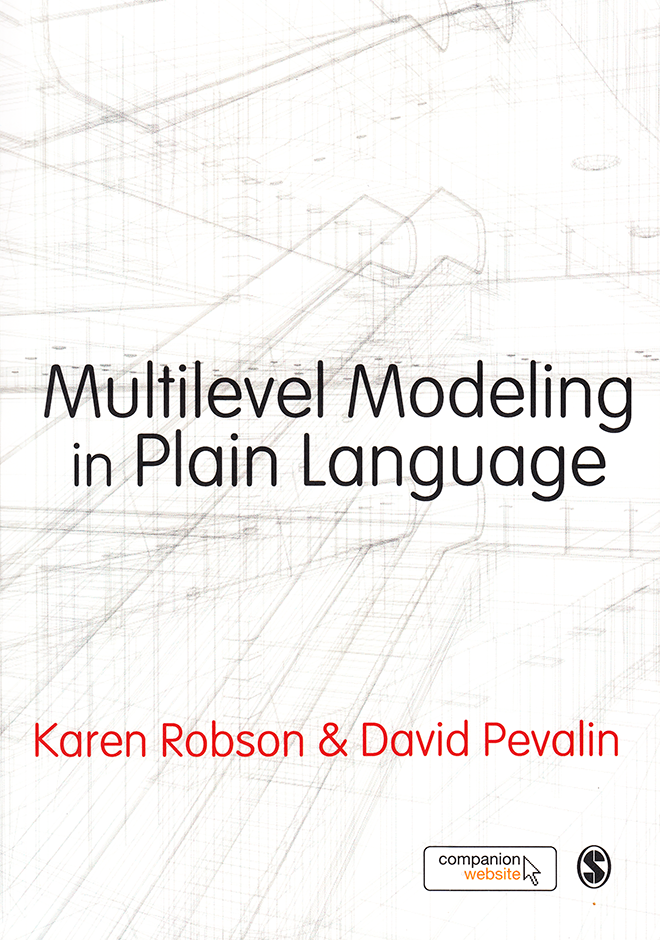

2025 Stata Economics Virtual Symposium • 6 November
Multilevel Modeling in Plain Language |
||||||||||||||||||||||||||||||||||||
 Click to enlarge See the back cover |

As an Amazon Associate, StataCorp earns a small referral credit from
qualifying purchases made from affiliate links on our site.
eBook not available for this title
eBook not available for this title |
|
||||||||||||||||||||||||||||||||||
Comment from the Stata technical groupMultilevel Modeling in Plain Language by Karen Robson and David Pevalin is a unique book on multilevel modeling. As the authors point out in their introduction, This book is for people who want to learn about this technique but are not at all interested in learning all the statistical equations and strange notations that are typically associated with teaching materials in this area. That is not to say we are flagrantly trying to promote bad research, because we are not. We are trying to demystify these types of approaches for people who are intimidated by technical language and mathematical symbols. To this end, the book provides a conceptual understanding of multilevel models and the motivation for using them. The book includes many examples, all worked using Stata. The first chapter provides an overview of the types of data for which multilevel models are often used. The authors then present arguments for choosing a multilevel model over another model, such as linear regression, when modeling such data. The second and third chapters introduce random-intercept and random-coefficient models. These chapters demonstrate how to use Stata's xtreg and mixed commands to fit models. They also discuss topics such as model building, model fit, and diagnostics. Here Robson and Pevalin demonstrate fitting two-level linear models, but the concepts presented can easily be extended to more complex models. The fourth chapter focuses on how to present the results of multilevel models—both in tables and in graphs created by the marginsplot command. This book is a great resource for anyone looking for a nontechnical introduction to multilevel modeling and to fitting these models using Stata. |
||||||||||||||||||||||||||||||||||||
Table of contentsView table of contents >> About the Authors
1 What Is Multilevel Modeling and Why Should I Use It?
2 Random Intercept Models: When intercepts vary
3 Random Coefficient Models: When intercepts and coefficients
vary
4 Communicating Results to a Wider Audience
References
Index
|
||||||||||||||||||||||||||||||||||||
Learn
Free webinars
NetCourses
Classroom and web training
Organizational training
Video tutorials
Third-party courses
Web resources
Teaching with Stata
© Copyright 1996–2025 StataCorp LLC. All rights reserved.
×
We use cookies to ensure that we give you the best experience on our website—to enhance site navigation, to analyze usage, and to assist in our marketing efforts. By continuing to use our site, you consent to the storing of cookies on your device and agree to delivery of content, including web fonts and JavaScript, from third party web services.
Cookie Settings
Last updated: 16 November 2022
StataCorp LLC (StataCorp) strives to provide our users with exceptional products and services. To do so, we must collect personal information from you. This information is necessary to conduct business with our existing and potential customers. We collect and use this information only where we may legally do so. This policy explains what personal information we collect, how we use it, and what rights you have to that information.
These cookies are essential for our website to function and do not store any personally identifiable information. These cookies cannot be disabled.
This website uses cookies to provide you with a better user experience. A cookie is a small piece of data our website stores on a site visitor's hard drive and accesses each time you visit so we can improve your access to our site, better understand how you use our site, and serve you content that may be of interest to you. For instance, we store a cookie when you log in to our shopping cart so that we can maintain your shopping cart should you not complete checkout. These cookies do not directly store your personal information, but they do support the ability to uniquely identify your internet browser and device.
Please note: Clearing your browser cookies at any time will undo preferences saved here. The option selected here will apply only to the device you are currently using.